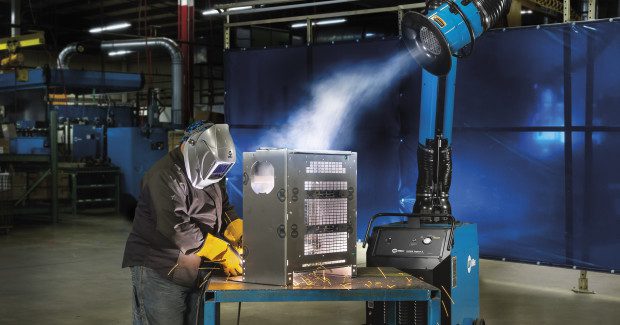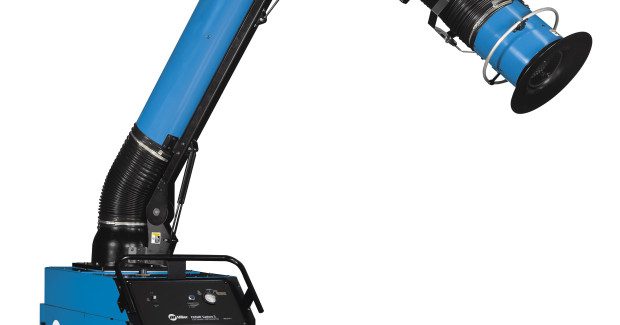Advanced Source Capture Technology Creates Larger Area for Weld Fume Capture
Employing source capture in the welding operation helps maintain compliance with regulations, avoid potential fines and create a safe and comfortable work environment. Because selecting the appropriate type of system for a given welding operation can be more difficult, here are some factors to consider in terms of cost, space requirements and the actual welding application.
Posted: April 30, 2014
Source capture technology is an effective option for companies to control weld fume, maintain compliance with environmental regulations and increase employee safety. The ability to capture fume at the source — before it reaches a welding operator’s breathing zone — is critical to maintaining a clean work environment for employees and keeping the facility itself clean.
Recent advancements in source capture technology are making it an even better defense against weld fumes, resulting in a safer and more productive welding environment. New source capture technology is available that creates a much larger fume extraction area than what was previously offered in the marketplace — up to 3 ft wide and 5 ft away (compared to the average of 12 in to 18 in away). This larger capture zone minimizes operator interaction with the fume extraction arm, which helps increase productivity and improve weld quality by reducing the need to pause repeatedly for adjustments.
WHEN AND WHY TO CONSIDER SOURCE CAPTURE
The push to establish and maintain safer work environments is, in part, the result of increasingly stringent regulations and recommendations for controlling weld fume. The Occupational Safety and Health Administration (OSHA) and the American Conference of Governmental Industrial Hygienists (ACGIH) both have limits for elements such as manganese and other weld fume particulates.
http://youtu.be/FZwO1chLAOg
A demonstration and overview of the FILTAIR® Capture 5 weld fume extractor from Miller that features exclusive ZoneFlow™ technology, which creates a much larger capture area than existing source-capture products and is far more effective than ambient capture systems.
If a shop finds itself exceeding OSHA’s regulation for the permissible exposure limit (PEL) of weld fume — currently set at 5 mg per cubic meter for manganese, for example — or the threshold limit value (TLV) set forth by ACGIH — 0.02 mg per cubic meter for the same element — a practical fume management solution is a good way to address the problem. There are three key ways to implement a fume management solution.
- Process modification or substitution is a good first step in any effort to reduce weld fume. Companies can move toward a lower fume generation process when possible, modify weld settings and/or switch to low manganese wires to reduce the amount of fume generated. Work practice changes, such as teaching employees proper weld positioning to minimize exposure to the weld fume path, is another important step for protection.
- If the above efforts are not possible — or if a shop has implemented them but needs to consider additional efforts to further reduce weld fume exposure — implementing preferred engineering controls like source capture via an appropriate fume extraction system, is the next recommended step. Advanced source capture systems are a particularly effective option.
- For a final solution, the addition of personal protective equipment (PPE), such as powered air purifying respirators (PAPRs), air supply helmets and/or half-mask respirators, can help eliminate exposure and also cool the welding operator’s face with airflow.
As a point of focus, let’s discuss the second step in fume management solutions, particularly the workings and benefits of advance source capture technologies.
HOW ADVANCED SOURCE CAPTURE TECHNOLOGY WORKS
Advanced source capture technology works by way of a negative pressure zone. The extraction arm suctions in air at a standard fume capture rate of around 900 cfm, while simultaneously, clean filtered air moves out of the arm (at a point just above the hood portion of the extraction arm) at approximately a 90 deg angle.
Additionally, some of the air that discharges out of the extraction arm “short circuits” and circles back around, effectively allowing a portion of the filtered air to capture more fume particulates before being suctioned up again. Combined, these actions create a very defined area of source capture, which funnels the weld fume particulates toward the center of the arm to maximize the extraction process,

















